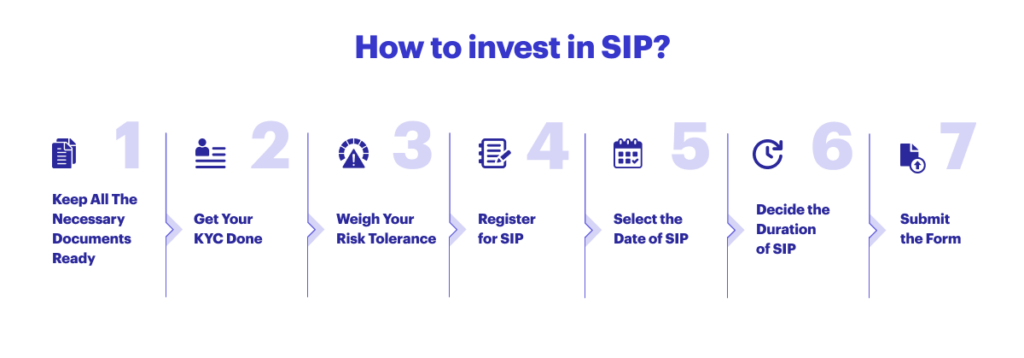SIP: Invest in the Best Systematic Investment Plans (SIP) for Beginners at smallcase

Are you new to investing and looking for a simple and effective way to grow your wealth? Look no further! In this blog, we’ll show you how to invest in SIP and make the most of your money. So, grab a cup of coffee and keep reading our SIP investment guide to learn more.
What is SIP?
The SIP full form is a Systematic Investment Plan. It is a long-term investment tool in which you can make regular automated investment decisions. Typically, your SIP investment plan can be done monthly, quarterly, or annually. Thus, you can learn how to invest in SIP via ETFs/ smallcase.
Think of SIP as planting a seed that grows into a big tree over time. You don’t need to water the tree every day or worry about it, but it steadily grows bigger and bigger. Similarly, SIP in the stock market means that you invest small amounts of money periodically, and your investment grows steadily, like a tree, without requiring constant attention.
For example,
Your SIP investment plan is to invest Rs. 500 for 4 years. You can easily set up SIP with your preferred amount that gets deducted from your bank account every month. Thus, you can also use a smallcase SIP calculator to get the actual amount i.e. Rs. 30,917 at a 12% interest rate after 4 years.
Still, thinking of how to invest in SIP? Let’s understand together.
Why is SIP Important?
Since SIP is immensely popular worldwide, the importance of SIP is no longer a secret. From what we have learnt during tough times of COVID, additional savings can help you in a great way. Thus, SIP investment plans have been the number one priority of even our parents.
Types of SIP
Before learning how to invest in SIP, let’s talk about the different types of SIP investment plans one can opt for.
- Fixed SIPs: In Fixed SIPs, you choose an amount, and a specific date on which the amount gets deducted and the rest of the process is automated.
- Top Up: Top-Up SIPs are an excellent way if you want to increase the SIP amount periodically and will make much more sense when your income is increased annually.
- Perpetual SIP: It means that a fixed amount will be credited from your bank account unless and until you instruct your bank to stop making withdrawals.
- Flexible SIP: A flexible SIP investment plan means that you can make adjustments to your contribution anytime within the tenure or skip a few of the contributions. Please note in flexible SIP, it is OKAY to skip a few dates without any penalties involved.
Factors to Consider Before Choosing the Right SIP
SIP or Systematic Investment Plan is one of the best ways to invest. An investor can set aside a predetermined amount beforehand for a set period of time. Thus, here are 5 factors you must consider before choosing the right SIP.
- Identify & Set Long-Term Goals: Identify the goal for which you want to start a SIP and then decide on a specific duration of time. A financial goal could be anything, hoping to pursue higher education abroad, marriage, house purchases, child’s education, etc. Thus, choose the plan wisely.
- Historical Performance & Returns: A comparison between the historical performance and return rate of a fund helps you understand if it is going to withstand or wither from market volatility. Thus, a careful analysis of your stock can help investors make a sound decision.
- Expense ratio: If your research boils down between the funds that are similar in nature, then you can easily differentiate with the help of the expense ratio. For example, SIP investment A and SIP investment B have an expense ratio of 1.5% and 1%. Even with similar returns, SIP investment A will outperform SIP investment B every year.
- Diversify Your Assets: Don’t put eggs in one basket. With the right kind of SIP investment plan, it is better to allocate assets depending on the risk tolerance.
How to Start SIP Investment for Beginners?
Here are some easy steps to answer how to start a SIP investment in India:

- Keep All The Necessary Documents Ready: To start, make sure you have all the required documents ready, such as your ID proof, PAN card, and address proof.
- Get Your KYC Done: To invest in financial products, you must comply with the KYC requirements set by the government. You can purchase a pre-paid card from any bank or post office in India.
- Weigh Your Risk Tolerance: Only the right SIP investment plans can give you favourable returns. Thus, before choosing a plan, ask yourself what is your risk tolerance and what type of investor you are.
- Register for SIP: You need to register the sip with any of the listed smallcase brokers like Zerodha or a financial advisor. Once registered, you can choose a variety of SIPs schemes or smallcases.
- Select the Date of SIP: SIPs are automatic debits from your bank account, so you will need to select a particular date when you are available to pay.
- Decide the Duration of SIP: SIP investment plans are the most convenient and efficient way to achieve your financial goals. You’re free to decide the duration of your SIP (3, 4, 5, 6, 7, 8, 9 or 10 years).
- Submit the Form: You can submit your SIP online if you have an online Demat account. Alternatively, you can submit it offline through post offices or your bank.
Calculate your SIP returns via smallcase SIP calculator today!
How to Customize Your SIPs?
Many people, especially employees with salary, prefer monthly SIPs. This is because it’s easy to move money from your bank to your chosen mutual fund when you get your monthly salary.
SIPs (Systematic Investment Plans) can be customized to meet your individual needs and goals. Here are some tips on how to customize your SIPs:
Choose the Right Investment Vehicle
There are a variety of investment vehicles available for SIP for beginners, such as mutual funds, ETFs, and index funds.Each type of investment vehicle has its own advantages and disadvantages, so it’s important to choose one that’s right for you. Consider your risk tolerance, investment goals, and time horizon when making your decision.
Set Up a SIP Minimum Amount
SIPs are all about investing regularly, so it’s important to set up a regular investment amount that you can afford to invest each month. You can start with a small amount and increase it over time as your income grows.
Choose the Right Investment Frequency
SIPs can be set up to invest monthly, quarterly, or even annually. The frequency you choose will depend on your investment goals and preferences. If you’re investing for the long term, you may want to consider investing monthly. This will help you take advantage of rupee-cost averaging, which can help you reduce your overall investment cost over time.
Rebalance Your Portfolio
As your investments grow and change, it’s important to rebalance your portfolio. This means selling some of your winners and buying more of your losers to maintain your desired asset allocation. Rebalancing can help you reduce your risk and stay on track to meet your investment goals.
Calculate Your Returns via smallcase Stock SIP Calculator
To give investors an estimate of the potential returns that they can expect, the SIP Lumpsum Calculator requires inputs such as:
- Initial investment amount
- Expected rate of return
- Investment tenure
By entering these details into the Lumpsum SIP calculator, investors can obtain an approximation of the investment’s future value. This empowers them to evaluate the potential growth and make well-informed decisions regarding their lumpsum investments.
SIP Charges & Tax Implications
One potential positive tax implication of SIP investing in smallcase is that it may offer greater tax efficiency. smallcases are typically pre-constructed portfolios that are diversified across multiple stocks, which can help to minimize the impact of taxes on your overall returns.
Furthermore, smallcases can also be structured as exchange-traded funds (ETFs), which can have tax advantages. Finally, smallcase portfolios may allow investors to implement tax-loss harvesting strategies, which involve selling losing positions to offset gains and reduce tax liability.
Thus, if you hold a SIP in smallcase for more than a year, any gains you make will be taxed as long-term capital gains, which are typically taxed at a lower rate. Overall, SIP investing in smallcase or portfolio investing can offer potential tax benefits for investors who are focused on minimizing their tax burden.
What are the Benefits of SIP?
SIPs can turn the odds in your favour. Let’s dive deep to understand how SIPs can be beneficial.
- Invest in a Disciplined Manner: Investing through SIPs in smallcase offers a disciplined approach to investing, enables diversification across multiple stocks or ETFs, and helps in reducing the overall risk of the investment.
- Rupee Cost Averaging: SIP Investing in smallcase provides the benefit of rupee cost averaging, where the investor can buy more units of a smallcase or be an active portfolio investing participant. This helps in reducing the impact of market volatility and creates long-term wealth for the investor.
- Compounding Grows Corpus: Thus, being an active investor in portfolio investing and staying consistent during the investment cycle will not bring returns on the new amounts you invest but also on the returns you have already earned. This is called compounding and many investors forget about it.
- Customization: Through a smallcase website or smallcase app, you easily customize the stocks that are worthy of investment. So, now with a smallcase basket, you can make an informed decision to invest, track, and manage your OWN smallcases.
SIP or One-Time: How Should You Invest?
It’s natural for first-time investors to get confused between choosing between an SIP investment or one-time investment. Therefore, we have listed differences that you might want to know before investing.
| Factor | SIP | One-time |
| Investment amount | Small, regular amounts | Large sum in one go |
| Market timing | Not required | Important |
| Risk | Lower | Higher |
| Discipline | Encouraged | Requires self-discipline |
| Convenience | Automated | Manual |
| Suitability | For all types of investors | For investors with a large sum of money and market timing skills |
Investing in smallcase via SIP
What is a smallcase?
smallcase is like a combo meal in the stock market, offering a pre-selected basket of stocks, curated by SEBI-registered research analysts. Since the portfolios are formed and researched by experts, investing in smallcase portfolios is the best way. That said, smallcase is safe. smallcase investment plans offer themes and strategies, such as large-cap stocks, value investing, dividend yield, and more. Thus, start a SIP with smallcase for customized portfolios from 500+ stocks that match your investment plan and risk appetite.
How to Invest in SIP via smallcase?
- Buy & Start SIP: Between smallcase vs mutual fund, it is possible and easier to adopt a disciplined approach to portfolio investing in smallcase. Thus, you can start buying and investing in your preferred smallcase portfolio via smallcase website or smallcase app in just one click.
2 important things to keep in mind:
- Check whether your smallcase broker provides for SIP orders or you can simply view your broker FAQ details for further information.
- For manual SIP, you will be notified via WhatsApp, mail, or push notifications around your due date.
- Start SIP via smallcase: Since smallcase portfolios are divided on a free and subscription basis, the minimum SIP amount depends on the smallcase portfolio. For example, Equity and Gold smallcase portfolio starts from 294 rupees and Rising Rural Demand smallcase portfolio starts from 40, 492 rupees.
- You can buy a smallcase and set a SIP reminder in 1 click: Once you’ve confirmed the SIP amount, a checked Monthly SIP reminder pop-up will appear. After clicking on ‘Buy & Start SIP’, the system will send you a reminder for the due date. Since the smallcase is flexible, you can easily change the SIP configuration anytime.
Disclosure for Rural Demand smallcase
Disclosure for Equity & Gold smallcase
How Does SIP on smallcases Work?
- Selection of smallcase – You must choose a smallcase, a pre-selected basket of stocks or ETFs grouped under a particular investment theme or strategy.
- Selection of SIP Frequency and Amount – Once the investor has chosen a Smallcase, they need to decide the amount and SIP frequency, which can be monthly, quarterly, or any other interval of their choice.
- Creation of Mandate – An investor must create a mandate with their bank authorizing it to transfer the minimum SIP amount to their smallcase at the selected frequency on the basis of their investment amount plan.
- Execution of SIP – The SIP amount gets transferred automatically from the your bank account to the smallcase platform, once the mandate is set. Based on the current stock market price, the smallcase algorithm purchases the stocks or ETFs in the smallcase.
- Tracking of Performance – You can track the performance of your smallcase through the smallcase dashboard or other investment tracking tools. Additionally, they can adjust their minimum SIP amount or frequency depending on their changing investment plans and risk appetite.
Why Choose SIPs in smallcase?
SIP Investing in smallcase offers a disciplined approach to portfolio investing. It offers rupee cost averaging, diversification across stocks or ETFs, and reduces investment risk. It is a convenient way to invest in a curated smallcase basket of stocks and ETFs.
SIPs in smallcase can be a good investment option for you. It offers the convenience of automated and regular investments. Therefore, set up a bank mandate for hassle-free SIP investment without constant market monitoring.
As an investor, you can choose the SIP amount and invest in smallcase. New investors who wish to experience our SIP investments, can refer to our best smallcases under ₹5000.
To Wrap It Up…
By investing small amounts via SIPs in smallcase, you can avoid market ups and downs by averaging small amounts regularly. What are you waiting for? Start your stock portfolio investment journey today!
FAQs
Yes, you can start SIP in smallcase. You can do it in two ways: (1) choose monthly SIP when making a fresh investment, or (2) from your investments, select a smallcase and click on “Start SIP”.
While SIPs can be a relatively safer approach in the stock market, it carries certain degree of risks as well.
The minimum amount you need to start a SIP is ₹500 in most cases. However, at smallcase it starts from ₹294 only.
Yes, you can withdraw your SIP in smallcase anytime. However, there may be some charges associated with the withdrawal. The exact charges will depend on the smallcase you are invested in.
All You Need to Know About Starting Your Share Market Journey
Share market investments can seem a bit tedious at first but smallcase is here to simplify all your queries and worries. Right from “Share market for beginner”, “Portfolio Diversification” to “short term investments” we’ve got all the tips, just a single click away –





























































